jimlindstrom
Member
Hi - I'm an avid digital photographer dipping my toes into film (shooting and development). I made a pair of simple pinhole cameras. I'm shooting Ilford FP4+ 4x5 B/W. I'm trying to develop them at home in trays, using the shuffle method.
After 4 pairs of shots, one camera seems like a lost cause, but with the other I can consistently get a BARELY-detectable hint of an image and lots of weird development artifacts. With each pair of shots, I have learned and fixed a few prior mistakes, but I'm still nowhere close to a recognizable negative of my scene. (E.g., I initially wasn't controlling the temp well enough, I don't think I was agitating enough, I didn't expose even close to the right time, etc.)
Can anyone diagnose what I'm doing wrong from this last negative? Here's the developed sheet, held against a lightbox (my thumb in bottom right), snapped with iPhone:

I am using Ilford DD-X to develop, and stop and rapid fix. (No pre-wash.) I did 12:00 of development for two sheets, emulsion side up. First half shuffling continuously, swapping sheets every ~5 seconds slowing down to every ~10 seconds. In the second half, I swapped sheets every 30 seconds. I shuffled bottom to top and attempted to very gently place the new top sheet down without much pressure. I rotated 90 degrees periodically. My bath is pretty shallow, JUST barely covering the stack. I temp controlled, starting about 21.0C and dropping to 19.0C throughout. (My basement is cold.)
The "camera" I built holds the 4x5 in place with some strips of cardboard, and you can see on the bottom and right of this frame, the white areas are where that cardboard masked the image slightly. (Yes, it was loaded crooked.) The top left faint gray rectangle is where the film saw light and was exposed, though I see no trace of the image there that I hoped to register.
Here's an overhead shot of my setup. The camera on the right in this image is the one you're seeing the negative from. (It's fairly dark, as you can see, but not yet "night photography" conditions. This exposure was for 10 minutes.)

After 4 pairs of shots, one camera seems like a lost cause, but with the other I can consistently get a BARELY-detectable hint of an image and lots of weird development artifacts. With each pair of shots, I have learned and fixed a few prior mistakes, but I'm still nowhere close to a recognizable negative of my scene. (E.g., I initially wasn't controlling the temp well enough, I don't think I was agitating enough, I didn't expose even close to the right time, etc.)
Can anyone diagnose what I'm doing wrong from this last negative? Here's the developed sheet, held against a lightbox (my thumb in bottom right), snapped with iPhone:
I am using Ilford DD-X to develop, and stop and rapid fix. (No pre-wash.) I did 12:00 of development for two sheets, emulsion side up. First half shuffling continuously, swapping sheets every ~5 seconds slowing down to every ~10 seconds. In the second half, I swapped sheets every 30 seconds. I shuffled bottom to top and attempted to very gently place the new top sheet down without much pressure. I rotated 90 degrees periodically. My bath is pretty shallow, JUST barely covering the stack. I temp controlled, starting about 21.0C and dropping to 19.0C throughout. (My basement is cold.)
The "camera" I built holds the 4x5 in place with some strips of cardboard, and you can see on the bottom and right of this frame, the white areas are where that cardboard masked the image slightly. (Yes, it was loaded crooked.) The top left faint gray rectangle is where the film saw light and was exposed, though I see no trace of the image there that I hoped to register.
Here's an overhead shot of my setup. The camera on the right in this image is the one you're seeing the negative from. (It's fairly dark, as you can see, but not yet "night photography" conditions. This exposure was for 10 minutes.)











